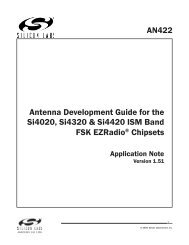C8051F326/7 - Silicon Labs
C8051F326/7 - Silicon Labs
C8051F326/7 - Silicon Labs
You also want an ePaper? Increase the reach of your titles
YUMPU automatically turns print PDFs into web optimized ePapers that Google loves.
12.10.2.Endpoint0 IN Transactions<br />
<strong>C8051F326</strong>/7<br />
When a SETUP request is received that requires USB0 to transmit data to the host, one or more IN<br />
requests will be sent by the host. For the first IN transaction, firmware should load an IN packet into the<br />
Endpoint0 FIFO, and set the INPRDY bit (E0CSR.1). An interrupt will be generated when an IN packet is<br />
transmitted successfully. Note that no interrupt will be generated if an IN request is received before firmware<br />
has loaded a packet into the Endpoint0 FIFO. If the requested data exceeds the maximum packet<br />
size for Endpoint0 (as reported to the host), the data should be split into multiple packets; each packet<br />
should be of the maximum packet size excluding the last (residual) packet. If the requested data is an integer<br />
multiple of the maximum packet size for Endpoint0, the last data packet should be a zero-length packet<br />
signaling the end of the transfer. Firmware should set the DATAEND bit to ‘1’ after loading into the<br />
Endpoint0 FIFO the last data packet for a transfer.<br />
Upon reception of the first IN token for a particular control transfer, Endpoint0 is said to be in Transmit<br />
Mode. In this mode, only IN tokens should be sent by the host to Endpoint0. The SUEND bit (E0CSR.4) is<br />
set to ‘1’ if a SETUP or OUT token is received while Endpoint0 is in Transmit Mode.<br />
Endpoint0 will remain in Transmit Mode until any of the following occur:<br />
1. USB0 receives an Endpoint0 SETUP or OUT token.<br />
2. Firmware sends a packet less than the maximum Endpoint0 packet size.<br />
3. Firmware sends a zero-length packet.<br />
Firmware should set the DATAEND bit (E0CSR.3) to ‘1’ when performing (2) and (3) above.<br />
The SIE will transmit a NAK in response to an IN token if there is no packet ready in the IN FIFO<br />
(INPRDY = ‘0’).<br />
12.10.3.Endpoint0 OUT Transactions<br />
When a SETUP request is received that requires the host to transmit data to USB0, one or more OUT<br />
requests will be sent by the host. When an OUT packet is successfully received by USB0, hardware will set<br />
the OPRDY bit (E0CSR.0) to ‘1’ and generate an Endpoint0 interrupt. Following this interrupt, firmware<br />
should unload the OUT packet from the Endpoint0 FIFO and set the SOPRDY bit (E0CSR.6) to ‘1’.<br />
If the amount of data required for the transfer exceeds the maximum packet size for Endpoint0, the data<br />
will be split into multiple packets. If the requested data is an integer multiple of the maximum packet size<br />
for Endpoint0 (as reported to the host), the host will send a zero-length data packet signaling the end of the<br />
transfer.<br />
Upon reception of the first OUT token for a particular control transfer, Endpoint0 is said to be in Receive<br />
Mode. In this mode, only OUT tokens should be sent by the host to Endpoint0. The SUEND bit (E0CSR.4)<br />
is set to ‘1’ if a SETUP or IN token is received while Endpoint0 is in Receive Mode.<br />
Endpoint0 will remain in Receive mode until:<br />
1. The SIE receives a SETUP or IN token.<br />
2. The host sends a packet less than the maximum Endpoint0 packet size.<br />
3. The host sends a zero-length packet.<br />
Firmware should set the DATAEND bit (E0CSR.3) to ‘1’ when the expected amount of data has been<br />
received. The SIE will transmit a STALL condition if the host sends an OUT packet after the DATAEND bit<br />
has been set by firmware. An interrupt will be generated with the STSTL bit (E0CSR.2) set to ‘1’ after the<br />
STALL is transmitted.<br />
Rev. 1.1 105


